calsfoundation@cals.org
George Clinton Douthit (1908–1985)
George Clinton Douthit was a reporter for the Arkansas Democrat newspaper continuously from 1945 until his departure in 1970 to join former governor Orval Faubus’s failed political comeback. He then founded the State News Bureau, an operation from which he sold news stories from and about the Arkansas State Capitol to small community newspapers around the state. When he died in 1985 after a long battle with cancer, a group of people, including Secretary of State W. J. “Bill” McCuen and widow Mary Lou Douthit, hung a photo inside the Capitol press room of Douthit; a small brass plaque identifies him as the “Dean of the Capitol press corps.”
George Douthit was born to James David Douthit and Obelia Douthit in Kingsville, Texas, on October 28, 1908. Obelia Douthit later died giving birth to Douthit’s only brother, and for one year the four Douthit children lived in an orphanage. In his youth in San Antonio, Texas, Douthit began reporting box scores for local baseball games for the city’s Express newspaper for $1.50 each. He quit school at sixteen after completing only the ninth grade, deciding that newspapering was both an education and a livelihood.
The sports editor at the San Antonio Light hired him, and Douthit worked there for a while before quitting to join the Evening News. A year later, he left that $20-a-week position for one making $35 at the Texarkana Gazette. By the mid-1930s, Douthit was a one-man Fort Smith (Sebastian County) bureau operation for the Associated Press (AP). In 1935, it moved him to Hot Springs (Garland County), where, among other complaints, he sometimes was not paid for weeks. “In all his life Douthit never was afflicted with a job that paid very much money,” he later wrote of himself.
By 1940, he had begun working for the Democrat, where he was assigned to report on Camp Robinson but soon found himself enlisted there as the United States ramped up for World War II. During the war, Douthit discovered firsthand the power of the printed image in journalism. (He was later credited by longtime Democrat editor Robert McCord for, along with Larry Obsitnik, moving the two major papers—and Arkansas—into the era of photojournalism.) He ended his service in a quartermaster truck company with Patton’s Third Army in France and Germany.
In 1947, Douthit married Mary Lou Collier and legally adopted her daughter, Lana.
In 1954, covering state politics but untenured, Douthit had the unenviable beat of covering Orval Faubus, the upstart Democratic gubernatorial candidate from the Ozark foothills whom most said did not have a chance against incumbent Francis Cherry (or even sensationalist Faulkner County senator Guy “Mutt” Jones). “Douthit got scoop after scoop for the Democrat through the Faubus years,” wrote journalist John Robert Starr years later in his book Yellow Dogs and Dark Horses. With Faubus secluded in the Governor’s Mansion, reporters for Time, Life, and the New York Times produced second-hand reports based on Douthit’s reporting, who often presented the governor’s views sympathetically. For example, Douthit wrote during the Little Rock Central desegregation crisis in 1957: “Arkansas Governor Faubus has become a nationwide symbol of resistance to integration, but few people understand that he does not control either the resistance or the removal of it.’”
Douthit continued on in Faubus’s favor until he upbraided Faubus at a press conference for the governor’s acquiescence to the renewal of corporal punishment inside the state’s prisons. The separation between Douthit and Faubus was brief, however, as Douthit’s first job upon leaving the newspaper in 1970 was to go to work for Faubus’s reelection effort. He also briefly served as an assistant to the president of Fagan Electric Co., handling public relations and advertising. For the greater part of the 1970s, he helped develop a capital city bureau for Donrey Media.
It appears that Douthit quit the Democrat of his own volition. According to editor Tucker Steinmetz, Douthit handed in an article about Faubus that was “kind of impossible to follow,” and, with an AP story at the ready, Steinmetz used it instead of Douthit’s. Steinmetz said that Douthit, in response, “threw a kind of a snot-slinging fit in the newsroom, a horrible fit” and quit.
In 1976, he began the State News Bureau, a one-man state capital reporting job run partly out of the house he shared with his wife. He aimed to serve readers in far-flung corners of the state with weekly commentary and state government news. Upon his death, one such weekly in Morrilton (Conway County) said the following in an unsigned editorial: “His State News Bureau was not only valuable for the insight into state politics and government he put into his columns and the reporting of state government news, it also was valuable in that it provided weekly newspapers which took advantage of it as an ‘in’ into state government functions which they would not otherwise have had.”
Around 1980, he developed a cancer that eventually spread to multiple organs. He died on May 15, 1985.
After his death, a group comprising fellow journalists Starr, Jon Kennedy, H. R. Herbie Byrd, Alyson LaGrossa (later Hoge), and his stepdaughter, Lana Bethune, founded the George C. Douthit Scholarship Trust. In 1986, Stephens, Inc., made a donation of $10,000 to it through City Trust, bringing the total to $13,000. Thirty years later, Lana Bethune (married to Congressman Ed Bethune), in her capacity as trustee, signed over the balance of the scholarship trust—more than $75,000—to the University of Arkansas at Little Rock, where it was used to establish the George C. Douthit Endowed Scholarship for a UA Little Rock student to participate in an internship or graduate fellowship with Arkansas Public Media, a publicly funded journalism collaboration that provides news online and in radio and television broadcasts.
For additional information:
George C. Douthit Papers. Special Collections. University of Arkansas Libraries, Fayetteville, Arkansas.
“Longtime Reporter Dies at 76: Covered Capitol.” Arkansas Gazette, May 16, 1985, p. 16A.
McConnell, Jerry. The Improbable Life of the Arkansas Democrat: An Oral History. Fayetteville: University of Arkansas Press, 2016.
Petrucelli, Fred. “Journalist Recalls Personal Encounters: Newspaperman Remembers ‘Impact Players’ He Has Met over the Course of a Half Century of Work.” Log Cabin Democrat, January 1, 2000. Online at http://thecabin.net/stories/010100/sty_0101000077.html#.WVUdzojytPZ (accessed July 17, 2017).
Starr, John Robert. Yellow Dogs and Dark Horses: Thirty Years on the Campaign Beat. Little Rock: August House, 1987.
Bobby Ampezzan
Arkansas Public Media
 Mass Media
Mass Media World War II through the Faubus Era, 1941 through 1967
World War II through the Faubus Era, 1941 through 1967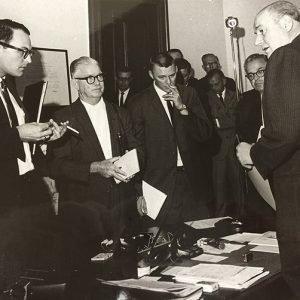 George Douthit, Winthrop Rockefeller
George Douthit, Winthrop Rockefeller 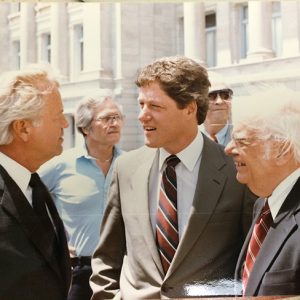 George Douthit and Bill Clinton
George Douthit and Bill Clinton 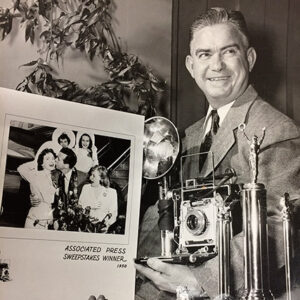 George Douthit
George Douthit 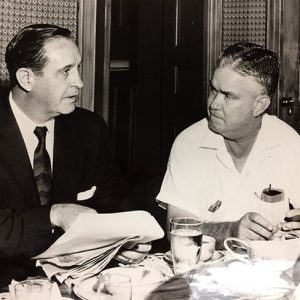 Faubus and Douthit
Faubus and Douthit 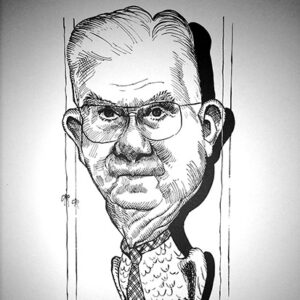 Douthit Caricature
Douthit Caricature 




Comments
No comments on this entry yet.